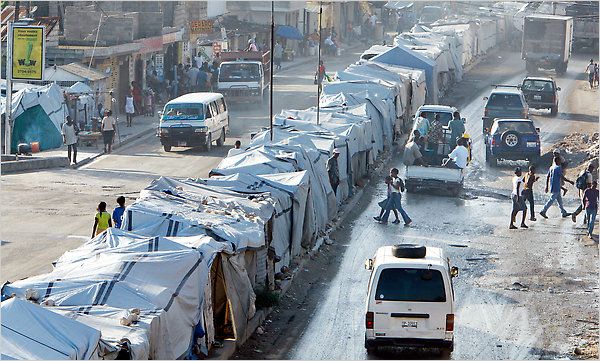(2 pm. – promoted by ek hornbeck)
Six months after the earthquake that devastated Haiti on 12th January 2010, this report describes the evolution of MSF’s work during what is the organisation’s largest ever rapid emergency response. It attempts to explain the scope of the medical and material aid provided to Haiti by MSF since the catastrophe, but also to set out the considerable challenges and dilemmas faced by the organisation. It acknowledges that whilst the overall relief effort has kept many people alive, it is still not easing some of their greatest suffering.
snip
The earthquake destroyed 60 per cent of the existing health facilities and 10 per cent of medical staff were either killed or left the country. MSF had to relocate services to other facilities, build container hospitals, work under temporary shelters, and even set up an inflatable hospital. With over 3000 Haitian and international staff working in the country, MSF currently manages 19 health facilities and has over 1000 beds available at various locations. The organisation has provided emergency medical care to more than 173,000 patients between January 12th and May 31st.
snip
Six months on, the medical provision for the majority of citizens has been significantly improved in general and some poor people who were unable to access healthcare prior to the disaster are now able to recieve care.
An extraordinary number of foreign aid workers had to be brought into the country quickly – two months after the earthquake MSF had more than 350 international staff on the ground -as many Haitian health workers themselves were also victims of the earthquake. This put a huge strain on MSF’s human resources and management capacity. MSF was eventually able to reduce the number of foreign workers, as more Haitians were hired to work in MSF facilities. By the end of May, 93 percent of MSF staff on the ground was Haitian.
MSF also reports that as of May 31, approximately $122 million was received in public donations earmarked for Haiti relief. The organization spent $71.5 million by that same date, including more than $14.8 million on surgery, $5.4 million on maternal health (MSF helped deliver 3,700 babies) and over $11 million providing shelter. MSF foresees that, by the end of the year, it will have spent around $120 million on assistance to the Haitian population. (Note: Figures are converted from Euros based on an average of currency exchange rates from January 12 to May 31.)
The NYT gives expanded coverage and realistic analysis of the situation in Haiti which is not promising or optimistic.

PORT-AU-PRINCE, Haiti – Hundreds of displaced families live perilously in a single file of flimsy shanties planted along the median strip of a heavily congested coastal road here called the Route des Rails. Vehicles rumble by day and night, blaring horns, kicking up dust and belching exhaust. Residents try to protect themselves by positioning tires as bumpers in front of their shacks but cars still hit, injure and sometimes kill them. Rarely does anybody stop to offer help, and Judith Guillaume, 23, often wonders why.
“Don’t they have a heart, or a suggestion?” asked Ms. Guillaume, who covers her children’s noses with her floral skirt when the diesel fumes get especially strong.
Six months after the earthquake that brought aid and attention here from around the world, the median-strip camp blends into the often numbing wretchedness of the post-disaster landscape. Only 28,000 of the 1.5 million Haitians displaced by the earthquake have moved into new homes, and the Port-au-Prince area remains a tableau of life in the ruins.
“ABC’s World News Tonight” did a commendable report of the last 6 months and the lack of progress in clearing the rubble and building permanent shelter for the displaced. David Muir also brought attention to the violence against women and girls that has increased. The link below contains the video of his report which also has interviews with MSF staff and some of the Catholic nuns who run one of the schools. There are several videos which unfortunately I haven’t found a way to embed them but are well worth watching.
Six months ago, after the catastrophic 7.3 magnitude earthquake struck Haiti, doctors were so desperate for medicine and supplies, some were forced to use vodka to sterilize equipment.
David Muir reports on whether the areas most in need have received your donation“We have no instruments, plaster of paris,” one doctor told us in the days following the earthquake.
Doctors performed surgeries with few supplies and dwindling medicine. ABC News was there with one surgeon as he performed an emergency c-section in a makeshift operating room, under a plastic tarp, while the mother was hemorrhaging. There was no blood to give her.
Today, the tarp where the doctor saved both mother and child is now an empty garage. Across the street is a brand new portable operating room. The surgeons with Doctors Without Borders call it their “holy room.”
“These are our sterile supplies,” the lead surgeon says as he points to the equipment they so desperately needed.
Up Date Mon Jul 12, 2010 at 18:22:33 PM EDT: President Clinton spoke with Anderson Cooper on the current situation in Haiti] and its future. Here is an excerpt from that interview which will air in full tonight on “Anderson Cooper 360”.

1 comments
Author